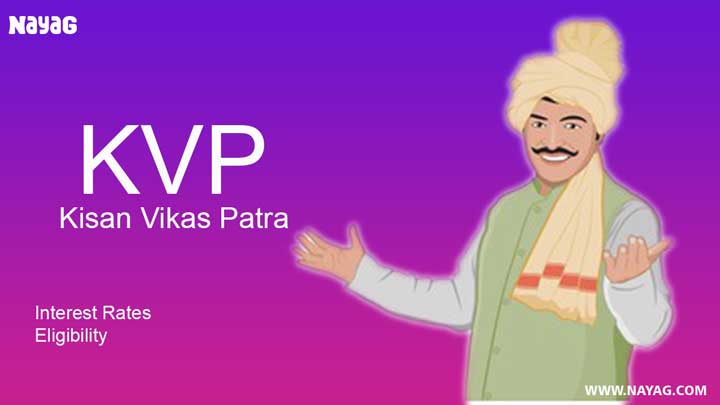A savings certificate scheme, Kisan Vikas Patra (KVP) was originally launched in the year 1988 by India Post. This is basically the Indian Government’s initiative to encourage small savings in the country for the investor’s secure future.
Kisan Vikas Patra Information
| Tenure | 124 months |
| Interest Rate | 6.9% |
| Investment Amount | Minimum: Rs.1,000Maximum: No Upper Limit |
| Tax Benefits | You can avail tax benefits under Section 80C of the Income Tax Act, 1961 |

Kisan Vikas Patra is a small savings instrument that facilitates people to invest in a long-term savings plan. This scheme was introduced by India Post in 1988. Even though this scheme was popular, a Government Committee formed in 2011 suggested that KVP could be misused for purposes like money laundering. In 2014, Kisan Vikas Patra was relaunched with a number of changes including mandatory PAN card proof for investments over Rs.50,000 and income source proof for investments exceeding Rs.10 lakh.
The main advantage of KVP investment is the availability and ease of process; KVP certificates are issued in Post Offices across the country. Any resident Indian can invest in a KVP scheme and can obtain a certificate either jointly or individually, or in the name of a minor. The principal amount invested in KVP will be doubled in 9 years and 4 months (i.e. 112 months) from when they were issued. The main target audience for this scheme is people in semi-urban and rural areas.
Also Read- Prime Minister Schemes List
Interest Rates Table for Post Office Savings Schemes
With an effective interest rate was reduced from 7.6% to 6.9%. (for Q1 of FY2020-21), Kisan Vikas Patra is a popular investment instrument given its low-risk and guaranteed returns. Interest is compounded annually.
Below is the time-table for change in interest rates for all Post Office Savings Schemes.
| S.No | Quater for which rate of interest would be effective | When it will be noticed | Rate of interest to be based on FIMMDA month end G-sec. rate pertaining to |
|---|---|---|---|
| 1 | April – June | 15th March | Dec-Jan-Feb |
| 2 | July – September | 15th June | Mar-Apr-May |
| 3 | October – December | 15th September | Jun-Jul-Aug |
| 4 | January – March | 15th December | Sep-Oct-Nov |
Now, as per the schedule, the Indian government has announced the new interest rates applicable to all Post Office Savings Schemes from 1st April 2020 to 30th June 2020.
| Instruments | Interest Rate for Q1 of FY2020-21 (1 Apr 2020 to 30 June 2020) | Interest Rate for Q2, Q3, and Q4 of FY2019-20 (1 July 2019 to 30 March 2020) | Interest Rate for Q1 of FY2019-20 (1 Apr 2019 to 30 June 2019) | Interest Rate for Q3 and Q4 of FY2018-19 (1 Oct 2018 to 31 Mar 2019) | Interest Rate for Q1 and Q2 of FY2018-19 (1 Apr 2018 to 30 Sep 2018) | Interest Rate for Q4 of FY2017-18 (1 Jan 2018 to 31 Mar 2018) | Interest Rate for Q3 of FY2017-18 (1 Oct 2017 to 31 Dec 2017) | Interest Rate for Q2 of FY2017-18 (1 July 2017 to 30 Sep 2017) | Interest Rate for Q1 of FY2017-18 (1 Apr 2017 to 30 June 2017) | Interest Rate for Q3 & Q4 of FY2016-17 | Interest Rate for Q1 & Q2 of FY2016-17 | Interest Rate for FY2015-16 |
|---|---|---|---|---|---|---|---|---|---|---|---|---|
| Kisan Vikas Patra (KVP) | 6.9% | 7.6% | 7.7% | 7.7% | 7.3% | 7.3% | 7.5% | 7.5% | 7.6% | 7.7% | 7.8% | 8.7% |
Kisan Vikas Patra Online
The process to invest in the Kisan Vikas Patra online scheme is simple. The steps mentioned below can be followed:
Kisan Vikas Patra
- You must obtain the KVP application form i.e. Form-A, from the post office.
- Furnish all the relevant details on the form and submit it at the post office.
- In case the investment is being made with the help of an agent, a second form will be required to be filled up and submitted. The agent must fill in Form-A1.
- Both the forms i.e. Form-A and Form-A1 are available for download on the official website as well. The forms can be downloaded online, filled up, and submitted.
- You will be required to furnish a copy of one of your identity proofs for the Know-Your-Customer (KYC) process. You can use one of the following documents – Aadhaar Card, Driving Licence, Passport, Voter ID Card, or PAN Card.
Your KVP Certificate will be issued once the documents provided by you are verified and the necessary deposits are made. You can also opt to receive the KVP Certificate through email. In that case, the certificate will be sent to you on the registered email ID.
Also Read-
- Atal Pension Yojana
- Voluntary Provident Fund
- Employees’ Provident Fund
- Public Provident Fund
- National Pension System
- SBI FASTag Apply
Kisan Vikas Patra Eligibility
The following are the Kisan Vikas Patra eligibility:
- The applicant must be an adult and a resident Indian.
- The applicant can apply for Kisan Vikas Patra in their own name or on behalf of a minor.
- Trusts are eligible to invest in Kisan Vikas Patra. HUFs (Hindu Undivided Family) and NRIs are not eligible to invest in KVP.
Kisan Vikas Patra Types
A Kisan Vikas Patra comes in the following types.
- Single Holder Type Certificate: This type of KVP is issued to an adult individually for self or on behalf of a minor.
- Joint A Type Certificate: This type of KVP is issued to 2 adults jointly and is payable to both the owners or to the survivor.
- Joint B Type Certificate: This type of KVP is issued jointly to two adults and is payable to either of the owners or to the survivor.
KVP, when of Type A and Type B, is released to both the combined owners. In case the adulthood is due to both the heir and owners or due to either of the heirs, it is released to combined owners.
Kisan Vikas Patra Interest Rate
The current interest rate was reduced from 7.6% to 6.9%. The maturity period was also increased from 113 months to 124 months. The principal amount can be withdrawn after this period only.
Here is an example of how interest accrues and doubles at maturity upon investment of Rs.1,000 in KVP on 1 October 2016 at an interest rate of 7.7%.
| Premature payments after | Amount payable (Rs.) |
|---|---|
| After 2 years 6 months or more but before 3 years | 1,176 |
| After 3 years more but before 3 years 6 months | 1,215 |
| After 3 years 6 months or more but before 4 years | 1,255 |
| After 4 years or more but before 4 years 6 months | 1,296 |
| After 4 years 6 months or more but before 5 years | 1,339 |
| After 5 years or more but before 5 years 6 months | 1,383 |
| After 5 years 6 months or more but before 6 years | 1,429 |
| After 6 years or more but before 6 years 6 months | 1,476 |
| After 6 years 6 months or more but before 7 years | 1,524 |
| After 7 years or more but before 7 years 6 months | 1,575 |
| After 7 years 6 months or more but before 8 years | 1,626 |
| After 8 years or more but before 8 years 6 months | 1,680 |
| After 8 years 6 months or more but before 9 years | 1,735 |
| After 9 years or more but before maturity | 1,793 |
| On maturity i.e. after 9 years 4 months | 2,000 |
Kisan Vikas Patra Maturity Period
The maturity period for Kisan Vikas Patra that was introduced in 2014 is 8 years and 4 months. On maturity, the amount invested gets doubled. If you invest an amount of Rs.10,000, after a period of 8 years and 4 months, the amount will increase to Rs.20,000. The current interest rate of Kisan Vikas Patra was reduced from 7.6% to 6.9%. therefore, the invested amount will double in 9 years and 5 months to 10 years and 3 months (i.e. 113 months to 124 months) for Q1 of FY2020-21.
Also Read-
- Pradhan Mantri Suraksha Bima Yojana
- Ayushman Bharat Yojana
- Sukanya Samriddhi Yojana
- Pradhan Mantri Kisan Samman Nidhi
- Pradhan Mantri Jeevan Jyoti Bima Yojana
Kisan Vikas Patra Form
In order to purchase a Kisan Vikas Patra certificate, one must fill in the application form and furnish the required information. The required information must be provided in the identity slip also. In the application form, you will be required to mention the following details:
- The amount for which KVP certificate is to be purchased.
- The method of payment which can be either cash or cheque
- Type of KVP certificate, whether it is single or joint “A” or joint “B”
- The name of combined owners if KVP type is not single
- In case of minor, the date of birth of the minor and his guardian who can encash KVP amount
- Name of all nominees with full address and date of birth
This form must be duly signed by the investor. The date, address, and signature of witness to nomination will also be specified in the slip.
In the identity slip, information like the serial number of KVP certificate, issue price, date of encashment, and postmaster signature and remarks like that of duplicate issue and transfer will be mentioned. To encash the KVP, one must present the identity slip. Hence, mentioning the right details in KVP identity slip and KVP Form is of utmost importance.
Kisan Vikas Patra Benefits
The following are some of the benefits of Kisan Vikas Patra Scheme:
- Long term Savings – With the Kisan Vikas Patra, you can start saving early with an amount as low as Rs. 1000. The Kisan Vikas Patra certificates can be bought for amounts as low as Rs. 1000 and going up to as much as you want. There is no upper limit on the amount that you wish to invest. The value is said to be doubled in 100 months i.e. 8 years and 4 months. The value that the holder will receive on the completion of the term is declared on the Kisan Vikas Patra certificate itself.
- 100% Security – We all want security on the investments that we make. The Kisan Vikas Patra scheme gives us just that. Since it is a Government owned scheme, the returns are fixed and secure. Since the amount that you will receive is declared on the certificate, you will have security on the investment that you have made and the amount that you will receive at the end of the term.
- Fixed Rate of Interest – Kisan vikas patra interest rate fixed on the amount that you are investing. This rate of interest ensures doubling of the principal amount in 100 months and is secured since it is a Government bond.
- Collateral for Loan – The Kisan Vikas Patra certificate can be used as a collateral while applying for a loan. Most banks and financial institutions accept this certificate as collateral before issuing you any loan.
- Non-Transferable – The benefits of kisan vikas patra is availed only by the holder of the Kisan Vikas Patra certificate. To have this transferred to another name, the permission of the Postmaster is required along with certain other formalities.
- Tax Benefits – At the time of encashment or disbursal of the Kisan Vikas Patra scheme, tax is not deducted at source; it is TDS exempted and paid in full to the holder. However, it is the responsibility of the certificate holder to pay the taxes on the interest accrued over the term of the scheme. This scheme is completely exempted from Wealth Tax.
- Physical Instruments of Investment – The Kisan Vikas Patra saving schemecomes as a simple printed certificate that can be saved in a physical form. There is no demat form for this certificate and cannot be traded for in the secondary market.
- Fixed Lock-in Period – The fixed lock in period on this scheme is two and half years. If you have an emergency financial requirement, you can encash this money prematurely after two and half years from the date of issuance with some amount of interest on the same.
KVP Rules and Guidelines
After relaunching KVP in 2014, the Government of India has specified a set of rules and guidelines for the same. As a KVP investor, you must be familiar with the KVP rules and they are given below for your reference.
- Title and commencement – All rules with regard to KVP scheme will be called the “Kisan Vikas Patra Rules, 2014” and will be effective the day they are published in the Official Gazette.
- The definition of certain words in the rules, unless the context otherwise requires, will mean the following:
- Act – Government Savings Certificate Act, 1959
- Cash – Indian Cash currency
- Certificate – Kisan Vikas Patra
- Form – Form annexed to these rules
- Post Office – Any departmental post office in India doing savings bank work
- Identity Slip – an identity slip issued to the holder of the certificate
- Bank – Any branch of the State Bank of India, all its associate banks and designated branches of commercial and nationalised banks that are authorised for the Public Provident Fund Scheme.
- Denomination of Certificates – Kisan Vikas Patra scheme certificates will be issued in denominations of Rs.1,000, Rs.5,000, Rs.10,000, and Rs.50,000 only.
- Application of Post Office Savings Certificate Rules, 1960 – The process of applying for the Kisan Vikas Patra remains unchanged and is same application process as that of the Post Office Savings Certificate Rules, 1960.
- Purchase of the Certificate – Any number of KVP certificates of the specified denominations can be purchased.
- Type of Certificates – The certificate for Kisan Vikas Patra can be issued as one of the following types:
- Single Holder Certificate – This certificate is issued to an adult for himself or on behalf of a minor or to a minor.
- Joint ‘A’ Type Certificate – This type of certificate is issued jointly to two adults and is payable to both the holders jointly or to the survivor.
- Joint ‘B’ Type Certificate – This type of certificate is issued jointly to two adults but payable to either of the two holders or the survivor.
- Issuance of Certificate – The KVP certificate is issued as soon as the payment is made. The date of the certificate is the same as the date of the payment. If for any reason, the Kisan Vikas Patra Certificate cannot be issued immediately, a provisional receipt is issued which can be later exchanged for a certificate.
- Procedure of Purchase of Certificate – The applicant needs to be present and submit an application form to buy a Kisan Vikas Patra. The payment for this certificate can be made by cash, a demand draft drawn in favour of the Postmaster or a signed withdrawal form or cheque.
- Transfer of Kisan Vikas Patra Certificate from one person to another person – A Kisan Vikas Patra can be transferred from one person to another person by writing to the postmaster requesting for the same. The following are the cases in which the transfer can be sanctioned:
- from the name of the deceased to their legal heir
- from a single holder to the names of the joint holder
- from a holder to the court of law or another person under the orders of a court of law.
- Pledging of Kisan Vikas Patra Certificate – On an application made in Form B by the transferor and transferee, the Postmaster may allow the transfer of any certificate as security at any time to
- The President of India or Governor of State
- The RBI or a Scheduled Bank or a Cooperative Society including a Cooperative Bank
- a Government agency or a Corporation
- a Housing Finance Company approved by the National Housing Bank and notified by the Central Government of India
- a local authority; provided that the transfer of the certificate on behalf of a minor shall not be permitted under this rule.
- Nomination – The purchaser of the certificate, single or joint holder can nominate any person who in the event of the death of the certificate holder shall be entitled to hold the certificate. The payment of the amount will be made to the nominee at the maturity of the scheme.
- Post Maturity Interest – When the repayment of the amount inclusive of interest is due and has not been made, the interest on the amount due shall be allowed under the following conditions:
- It will be simple interest and calculated at the rate applicable from time to time to Post Office Savings Account.
- Any part of the period, for the purpose of payment of interest, that is less than one month shall be ignored.
- The depositor can receive the interest in lump sum at the time of repayment of the due amount.
- Replacement of destroyed or Lost Certificate – If a Kisan Vikas Patra is lost, damaged or destroyed, the person can apply for a duplicate of the same at the post office or the bank where the certificate was not issued. If the application has been made to a post office or bank where it was not issued, the application will be forwarded to the right location. The application should have the certificate number, amount, and date and the circumstances of destruction, defacement, or loss. A duplicate certificate issued can be treated as an original certificate for all purposes except that it won’t be encashable without prior verification.
- Place of encashment of Kisan Vikas Patra – The certificate can be encashed at the post office or the bank where it was issued. It can also be encashed at another post office or bank provided the issuing authority is satisfied with the verification from the location of the issue and the person holding the certificate.
- Encashment of Kisan Vikas Patra on Maturity – For any denomination of certificate issued, the period of maturity will depend on the interest rate applicable on the date of issue of the certificate. The amount inclusive of interest which is payable while encashing a certificate after the expiry of the maturity period will be double of the deposited amount.
- Premature Encashment of Kisan Vikas Patra Certificate – The certificate can also be encashed before the completion of the maturity under certain circumstances such as the death of the holder or any of the holders, in case of a joint holder, when ordered by a court of law, or on forfeiture by pledge being a Gazetted Government Officer. The minimum lock-in period for this scheme is two and a half years and can be prematurely encashed any time after this period. The simple interest is calculated on the rate from time to time under the scheme.
- Discharge of Certificate – On the encashment of the certificate, the holder will sign at the back of the certificate as a sign of having received the payment.
- Rectification of mistakes – Any clerical and arithmetical mistakes with regard to the certificate can be rectified by the Postmaster General provided it does not cause any financial loss to the Government.
- Power to relax – If a holder is facing an undue hardship, the rules may be made flexible for them on humanitarian grounds, that is not inconsistent with the Act if recorded in writing and approved by the Central Government.
Kisan Vikas Patra Encashment
If you wish to encash a Kisan Vikas Patra Certificate, you can avail the same at the Post office where the KVP was issued. In case you need to encash it at a different post office, some formalities have to be completed. In order to encash a KVP, you need to submit the identity slip that was offered at the time of KVP certificate purchase. To encash a KVP certificate, all you have to do is give a letter in writing to the concerned post office and also present your identity slip.
If you wish to pull out your principal before maturity period, you can do so only after 2 years and 6 months. Kisan Vikas Patra can also be prematurely encashed before its maturity under the following circumstances:
- If ordered by a Court of law
- On forfeiture by a pledge or by a Gazetted Officer
- Upon the death of the KVP holder or any of the holders in the case of joint KVPs
How to Transfer Kisan Vikas Patra Account?
A Kisan Vikas Patra certificate can be transferred from one Post Office to the other or from one person to another.
Transfer from One Post Office to Another: A Kisan Vikas Patra certificate can be transferred from one post office, from where it was originally bought to another post office. In order to transfer a KVP certificate, the investor must submit a handwritten consent to the officer at a concerned post office. The transferee must be a resident Indian and must be eligible to purchase the KVP certificates.
Transfer from One Person to Another: A KVP certificate can also be moved from one individual to another for which a written letter must be submitted to the Post Office for the same. The following conditions/specifications apply for the same:
- Transfer from name of deceased to his or her heir
- From one owner to the combined owners
- From combined owners to name of one of the owners
- From the owner to a judge of law and also to other individuals as ordered by a Court of Law
Kisan Vikas Patra Withdrawals
A Kisan Vikas Patra scheme can be closed before maturity. The principal along with the interest can be withdrawn. The period for premature withdrawal of KVP is after 2 years and 6 months from the date of issuance, which is also the lock-in period. To avail KVP pre-mature withdrawal, the holder must give in writing to the Post Office following which the amount will be given. KVP encashment is not allowed unless the KVP holder is deceased or only upon court orders.
Loan Against KVP
A holder of Kisan Vikas Patra can avail a loan against the same. The following are the conditions for availing a loan against KVP:
- The loan applicant must have a Kisan Vikas Patra under his own name.
- The loan against KVP can be availed for business or personal purposes only. The loan cannot be availed for any speculative ones.
- Different banks have different charges and interest rates for loans against KVP. The charges vary from time to time and select banks may charge processing fee for loan grant.
- The loan should be repaid within the tenure of KVP.
- The margin and loan amount will be decided by the bank based on the KVP investment and maturity.
FAQs on KVP
I have lost my KVPs. What is the process to obtain a duplicate certificate?
To obtain a duplicate KVP certificate, you need to write to the Post Office of KVP issue requesting a duplicate certificate and attach the identity slip that was given at the time of issue. The identity slip will prove your ownership of KVPs. If you have lost or misplaced the identity slip, please contact the Post Office of issue for further instructions.
Can I invest Teachers’ Provident Fund in Kisan Vikas Patra scheme?
No, Teachers’ Provident Fund are not eligible to be invested in KVPs.
I have shifted to a different city. Can I encash my KVPs at the Post Offices here other than the Post Office of issue?
Kisan Vikas Patra can be encashed at any Post Office if your identity slip is accepted and if it is confirmed by the Post Office that you are the rightful owner. Ideally, it would be a lot easier for you if you could encash your KVP at the Post Office of issue.
Are Co-operative Societies and Co-operative Banks allowed to invest in Kisan Vikas Patra (KVP)?
No, Co-operative Societies and Co-operative Banks are not allowed to invest in Kisan Vikas Patra (KVP).
Can NRIs and HUFs invest in the KVP scheme?
No, KVP scheme is open only for resident individuals. NRIs and HUFs are not eligible to invest in Kisan Vikas Patra.
Are there any restrictions in terms of the amount that can be invested in Kisan Vikas Patra?
No, there are no restrictions in terms of the investment amount. There is, however, a minimum limit, which is Rs.1,000. Which means that one must invest a minimum of Rs.1,000 in the scheme. Thereafter, one can invest in denominations of Rs.1,000, Rs.5,000, Rs.10,000, and Rs.50,000. Also, there is no limit put on the number of certificates that an individual can hold.
What is the maturity period of Kisan Vikas Patra (KVP)?
The maturity period depends on the interest rate at which KVP is issued. The current interest rate was reduced from 7.6% to 6.9%. , the maturity period was also increased from 113 months to 124 months for KVP issued in the first quarter of FY 2020-21.
What is the current rate of interest that can be earned with this scheme?
The current rate of interest applicable on this scheme is 6.9% for Q1 of FY2020-21.
What will be the tax benefits for investing in Kisan Vikas Patra?
The returns received from the Kisan Vikas Patra are not eligible for any tax deductions under Section 80C of the Income Tax Act. However, withdrawals made after the maturity of the scheme are exempt from Tax Deducted at Source (TDS).
How long does it take for the Kisan Vikas Patra to be issued?
If an applicant has purchased a Kisan Vikas Patra by making payment for it in cash, they will be issued the certificate immediately. But, if the purchase has been made by cheque, pay order, or Demand Draft, then the date of issue of the certificate will be the date on which payment made using any of these instruments has been realised. However, if, despite making the payment, you have not been issued your KVP certificate, you will be provided with a provisional receipt for the same. When the actual certificate is issued at a later date, the applicant must exchange the provisional receipt with the KVP certificate. In such cases, the date of issue of the KVP shall be the date on which the provisional receipt had been issued.
Can Kisan Vikas Patra be transferred from one person to another?
Yes, a Kisan Vikas Patra can be easily transferred from one person to another. This can be done by providing a written letter of consent to the Post Master. In order to transfer, the original certificate holder should submit the original KVP certificate. The new certificate that is issued will bear the name of the transferee i.e. the person in whose name the certificate has been transferred. Transfer of certificate from one person to another will not be permitted if the Certificate is held either on behalf of a minor (till they are alive) or by a minor themselves.
What happens if the certificate is not encashed after the scheme reaches maturity?
In case the certificate is not encashed after the scheme reaches maturity, then the scheme holder will be entitled to the post office savings interest, at the rate applicable on the entire payable maturity amount, at the given time. If the certificate is encashed within a month after maturity of the scheme, no interest shall be paid.
Where can one encash a Kisan Vikas Patra (KVP)?
A kisan Vikas Patra can be encashed by the certificate holder at the bank or post office where the certificate was issued.
How will the maturity amount be paid?
On maturity of the scheme, the payable amount shall be credit directly to the bank/post office savings account of the certificate holder. Therefore, it is important that the certificate holder have a savings account when they are looking to encash their certificate.
We hope you have enjoyed our work, if you liked it Please help us reach more people like You. Share this article with your Friends using below buttons. Sharing is Caring 💗






